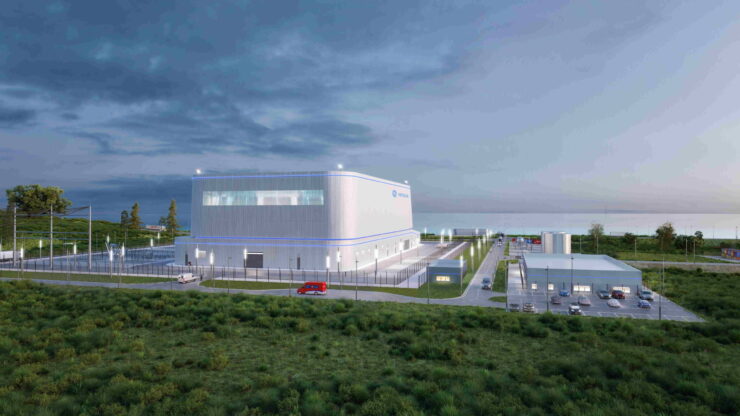GE Hitachi’s BWRX-300 Small Modular Reactor Gets Another Win

Fermi Energia, a privately held company formed to develop a small modular reactor (SMR) in Estonia, announced that it has selected GE Hitachi Nuclear Energy's (GEH's) BWRX-300 design for deployment.
Kalev Kallemets, CEO of Fermi Energia, said in September last year that the company's nuclear technology selection process had begun in 2019, with a mapping of a large list of companies from around the world that were all offering new advanced nuclear technologies. Decision-makers whittled that list down to the more successful" designs. From the successful ones, in turn, leaders chose the three they felt were most suitable for Estonian conditions and its electricity system. The company had sent tenders to GEH, NuScale, and Rolls-Royce on Sept. 15, with bids requested by December, including comprehensive technical documentation needed to estimate the construction cost. On Feb. 8, the group announced GEH had been selected as its top choice (Figure 1).
 1. GE Hitachi Nuclear Energy's (GEH'S) BWRX-300 is a 300-MWe water-cooled, natural circulation small modular reactor with passive safety systems that leverages the design and licensing basis of GEH's U.S. Nuclear Regulatory Commission-certified ESBWR. Courtesy: GEH
1. GE Hitachi Nuclear Energy's (GEH'S) BWRX-300 is a 300-MWe water-cooled, natural circulation small modular reactor with passive safety systems that leverages the design and licensing basis of GEH's U.S. Nuclear Regulatory Commission-certified ESBWR. Courtesy: GEHThere are dozens of new small modular reactors in development around the world-each of them is somehow different. Some developers are experimenting with more exotic technologies that will take a long time to reach market maturity, while others use tried and tested, functional and safe solutions. Estonia cannot be too bold an experimenter with its first nuclear power plant. It also sets a number of practical criteria for the choice of technology, which after thorough consideration fell to GE Hitachi," explained Marti Jeltsov, Chief Technology Officer of Fermi Energia.
The BWRX-300 is the 10th evolution of GE's boiling water reactor (BWR) design. The company says the BWRX-300 represents the simplest, yet most innovative BWR design since GE began developing nuclear reactors in 1955."
The BWRX-300 is in principle a boiling water reactor, which is used and well known by many European countries, including Finland and Sweden. However, the specific reactor model is much smaller than the ones used in the nuclear plants of our northern neighbors, which allows greater safety, lower cost, and shorter build time. At the same time, it is possible to rely on the experience of neighbors and offer the consumer clean electricity at an affordable and stable price," said Kallemets.
We are honored that our small modular reactor technology has been selected by Fermi Energia to help Estonia fulfill its energy security and climate goals," said Jay Wileman, president and CEO of GEH. This technology selection further validates the BWRX-300 as the leading SMR solution. By leveraging a unique combination of existing fuel, plant simplifications, proven components, and a design based on an already licensed reactor, the BWRX-300 offers cost-competitive, zero-carbon-emission generation in a meaningful timeframe."
The technology selection by Fermi Energia is the latest win for GEH's BWRX-300. In January, GEH, Ontario Power Generation (OPG), SNC-Lavalin, and Aecon announced the signing of a contract for the deployment of a BWRX-300 SMR at OPG's Darlington New Nuclear Project site. In August 2022, the Tennessee Valley Authority (TVA) began planning and preliminary licensing for potential deployment of a BWRX-300 at its Clinch River Site near Oak Ridge, Tennessee. And, in June last year, SaskPower announced that it had selected the BWRX-300 for potential deployment in Saskatchewan in the mid-2030s.
Meanwhile, ORLEN Synthos Green Energy (OSGE) and its partners started the pre-licensing process in Poland by submitting an application for assessment of the BWRX-300 to the country's National Atomic Energy Agency. OSGE plans to deploy a fleet of BWRX-300s with the potential for deployment of the first of those units by the end of this decade. GEH has also begun the design certification process for the BWRX-300 in the UK. The company said it has memoranda of understanding or other agreements in place with companies in Canada, Czech Republic, Poland, UK, U.S., and Sweden, among others, to support the global deployment of BWRX-300 technology.
However, there are still several hurdles to overcome in Estonia before construction begins. In order to build a nuclear power plant in Estonia, the Riigikogu-the unicameral parliament of Estonia-must consider the need and authorize nuclear energy in the country. Also, the initiation of a special national plan to find a suitable location for the plant, as well as the development of nuclear energy legislation are required.
Fermi Energia feels there is good support for nuclear power among citizens of Estonia. The company commissioned public opinion surveys in January, which were conducted by Kantar Emor and Norstat-two independent companies that collect data and do business consulting, analysis, and research in Estonia. Kantar Emor's study was the eighth completed since 2019. Norstat, however, went for the first time to interview the residents of Viru-Nigula and Luganus parishes. This was significant because these are potential siting locations for the nuclear power plant.
Kantar Emor reported that 61% of people it polled were in favor (34%) or somewhat in favor (27%) of considering the use of a new generation small nuclear power plant to ensure Estonia's electricity supply security." It said 17% were against (7%) or somewhat against (10%), and 23% did not have a clear position on this issue. The share of opponents of considering a nuclear plant is in a continuing downward trend," Fermi Energia said.
Norstat's survey in Viru-Nigula municipality in Laane-Virumaa and Luganus municipality in Ida-Virumaa was conducted door-to-door. It revealed that 50% of the residents of these municipalities were in favor or somewhat in favor of building a new generation small nuclear power plant in their home municipality, and 32% were against or somewhat against the prospect. Notably, the support percentages in each category were quite similar for both municipalities.
We have analyzed all the work ahead and consider it realistic to produce reliable, clean, and affordable nuclear energy in Estonia by Christmas 2031, which should also be in the interest of society and the country's climate goals. Understandably, this goal requires a serious effort from both the state and Fermi Energia," said Kallemets.
-Aaron Larson is POWER's executive editor (@AaronL_Power, @POWERmagazine).
The post GE Hitachi's BWRX-300 Small Modular Reactor Gets Another Win appeared first on POWER Magazine.